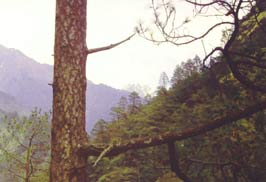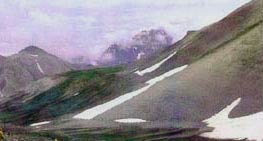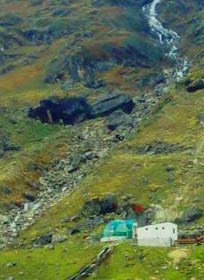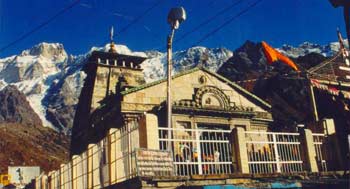| Pilgrim Places
| ||||||||||||||
My parents had expressed their desire to go for a pilgrimage to Kedar-Badri. Their only exposure to the mountains were trips to Ooty and Kashmir in the distant past. I remember both these trips as I had tagged along as an adolescent. Having been on the Kailash Manasarovar Yatra, I felt confident. Soaking in all the information I could get about these pilgrimages, I was particularly inspired by Umaprasad Mukherjee's extensive travels in the Himalayas, written in a Bengali book. I joined the "Durgapur Mountaineers' Association", the oldest among the three trekking clubs in my hometown. Reaching Haridwar at the end of May, we performed pujas at the Maya Devi temple, the reigning deity of Haridwar, and took a dip in the sacred Ganga. At 7.30 am, the next morning we left in a convoy of several 4 wheelers. The picturesque route was through the dense forests of the Rajaji National Park. On the way, we offered prayers at the Lakshman temple near Lakshman Jhula and I went down to the riverbed to catch a glimpse of the schools of fish that would surface for the puffed rice fed by pilgrims. From Rishikesh the road winds along the swift Ganges with forests on one side, and the hills extending below to the river, on the other. There are several ashrams en route, representing the myriads of sects of the Hindu religion, or the Sanatan Dharma. We passed the various rafting clubs along this stretch of the road, called Marine Drive. |
More on Uttarakhand • Overview • Uttarakhand Districts • Badrinath • Haridwar • Rishikesh • Char Dham • Mussoorie
Impressions
Pilgrimages
Trekking
Photo Gallery  Passing through Shivpuri we stopped for breakfast at Kaudiyala, on the banks of a now meandering Ganges. The eatery was beside the fast flowing but deceptively calm-looking chilly Ganges. GMVN has a wonderful guest house plumb on the riverside with its own private beach shielded from the eyes of passing tourists by a curtain of immensely tall conifers.
Passing through Shivpuri we stopped for breakfast at Kaudiyala, on the banks of a now meandering Ganges. The eatery was beside the fast flowing but deceptively calm-looking chilly Ganges. GMVN has a wonderful guest house plumb on the riverside with its own private beach shielded from the eyes of passing tourists by a curtain of immensely tall conifers.The road led to the main prayag (confluence of rivers) called Devprayag where the Ganga, as we know it, is formed from the confluence of the rivers Mandakini (Kedarnath), Alakananda (Badrinath) and Bhagirathi (Gomukh). From Devprayag we went ahead to Srinagar and crossing small idyllic villages and towns like Agastyamuni, we reached Kund. Here, a road branches to the right from the bridge outside Kund leading to Ukhimath, Chopta and further on, to Badrinath. From Kund the road goes through dense forests and sparely populated regions till it reaches Guptakashi with the last petrol pump on this route. There is a famous Shiva temple here. On a subsequent visit to Kedar I watched an old man in the bus fish out a fresh marigold from his tunic, tear a few petals, and offer them in reverence while mumbling mantras. I learnt that the offering was for Banasur, an ardent Shiva devotee, who had valiantly fought Sri Krishna, and whose abode was believed to be nearby.
Reaching here at 9 pm, I was keenly aware of the howling winds, the strong drizzle and the biting cold. My parents had a tough time. During my subsequent visit in October of the same year I saw it as a warm and endearing place! Open for pilgrims for 6 months in a year, there are several lodging houses. GMVN has a good guesthouse closer to where the trek route to Kedarnath begins. The river Mandakini flows past and its roar is almost frightening initially, though on the return journey it sounds soothing. One can buy provisions for the trek as well as woollens, film, dry-fruits and Puja samagri. There is a hot water spring called Taptakund where one can deservedly soak one's feet after returning from Kedarnath. The water is drained out each night and thoroughly cleaned for the next day's crowd. There is a beautiful temple of Gauri where the evening arati is performed with great devotion. The next morning, after several cups of tea I arranged for "dandis"(palanquins) for my parents and a young cheerful porter to carry our belongings, and started off at the late hour of 8.30 am. The path to Kedar is well paved, quite wide and mostly of low gradient. With great expectations in our hearts, the bright sunshine was a morale booster for my parents. I trudged along slowly with pilgrims from every corner of our diverse country who were loudly cheering, "Har Har Mahadev", "Jai Kedar", and "Bhole Baba Paar Karega". I was enjoying the crisp morning air, aware of the comforting regular familiar thumping of my heart in my chest and the tingling of sweat drying on my face. The atmosphere was charged with chanting, creating bonhomie and camaraderie. At bottlenecks along the path, the ponies made it rough for those on foot.
The small village of Kedarnath is situated at the far side of a soup bowl shaped clearing with the temple literally at the foot of the Kedarnath mountain. The temple stands etched against the splendid backdrop of the ice-capped mountains. The icy winds had left me chilled to the bone. It had taken me 8 hours to reach Kedar. Exhausted, we retired to the Bharat Sevashram Sangha, emerging from there only for the evening arati. Later that year, I returned and reached Kedar in 6 hours.
Om Namoh Shivay. Photo Credit: Biswarup Mukherjee Temple & Legends of Kedarnath ~ Biswarup Mukherjee
Editor: Romola Butalia (c) India Travelogue. All rights reserved. | |||||||||||||
 From Guptkashi we went to Sonprayag, 5 kms away. The effects of the change in altitude can be felt. The cold and the sombreness of nature warns the entrant of divine territory. As if on cue, the road gets steeper and rougher, requiring constant maintenance because of the regular upheavals of nature. This is the last place before Gaurikund where pilgrims can find board and lodging. The road passes through extremely dense forests with the occasional stream flowing over the road itself. The curves are tighter. There is a marked change in the temperament of the drivers as they concentrate on the road. In the silence is heard only the sound of nearby waterfalls, apart from the occasional screeching of the hot brake shoes and the groans of the heavier vehicles. Passing vehicles carrying pilgrims on their way down boasted exhausted and happy faces. Evening was fast approaching. One has to swallow hard to clear one's blocked ears. At last the vehicles reach Gaurikund - a small clearing in the mountains with a parking place, used to manoeuvre U-turns.
From Guptkashi we went to Sonprayag, 5 kms away. The effects of the change in altitude can be felt. The cold and the sombreness of nature warns the entrant of divine territory. As if on cue, the road gets steeper and rougher, requiring constant maintenance because of the regular upheavals of nature. This is the last place before Gaurikund where pilgrims can find board and lodging. The road passes through extremely dense forests with the occasional stream flowing over the road itself. The curves are tighter. There is a marked change in the temperament of the drivers as they concentrate on the road. In the silence is heard only the sound of nearby waterfalls, apart from the occasional screeching of the hot brake shoes and the groans of the heavier vehicles. Passing vehicles carrying pilgrims on their way down boasted exhausted and happy faces. Evening was fast approaching. One has to swallow hard to clear one's blocked ears. At last the vehicles reach Gaurikund - a small clearing in the mountains with a parking place, used to manoeuvre U-turns.
 Gaurikund to Rambada, midway to our destination, is an elevation of 2,000 m and a distance of 2 kms along amply tree-covered paths. From Rambada, at 2600 m, the gradient becomes steeper. The Mandakini remains a constant companion as it carves gorges on its way, well below the trekking path.
There are plenty of tea stalls serving tea/coffee, parantha-subji, aloo-puris, pakoras and Maggi noodles. Bottled mineral water, cold drinks and chocolates are available everywhere. Thereare covered benches, and toilets in sheds at intervals. Closer to Kedarnath, electric lights illuminate the path.
Gaurikund to Rambada, midway to our destination, is an elevation of 2,000 m and a distance of 2 kms along amply tree-covered paths. From Rambada, at 2600 m, the gradient becomes steeper. The Mandakini remains a constant companion as it carves gorges on its way, well below the trekking path.
There are plenty of tea stalls serving tea/coffee, parantha-subji, aloo-puris, pakoras and Maggi noodles. Bottled mineral water, cold drinks and chocolates are available everywhere. Thereare covered benches, and toilets in sheds at intervals. Closer to Kedarnath, electric lights illuminate the path.

 On the concrete path just before the bridge I experienced a sense of great joy as I saw the temple Dhwaja and heard the peals of the numerous bells. Approaching the bridge, on the left is a turbine powered by a small stream. The small hydel power plant lends abundant kinetic energy for electrification of the area, except when the streams are frozen over. Across the bridge on the left, the mountain slopes are verdant and dainty trails criss-cross the mountainside. On the right of the bridge a path on a severe mountain slope leads to the temple of Bhairavnath. With the ardours of the journey, most people miss it as they frantically rush down the next morning, after offering oblations at the Kedarnath temple, to reach the comfort of the lower altitudes at Gaurikund.
On the concrete path just before the bridge I experienced a sense of great joy as I saw the temple Dhwaja and heard the peals of the numerous bells. Approaching the bridge, on the left is a turbine powered by a small stream. The small hydel power plant lends abundant kinetic energy for electrification of the area, except when the streams are frozen over. Across the bridge on the left, the mountain slopes are verdant and dainty trails criss-cross the mountainside. On the right of the bridge a path on a severe mountain slope leads to the temple of Bhairavnath. With the ardours of the journey, most people miss it as they frantically rush down the next morning, after offering oblations at the Kedarnath temple, to reach the comfort of the lower altitudes at Gaurikund.  The temple of Kedarnath stands on a large raised platform, rectangular in shape, with tall snow clad mountains guarding Kedarnath from three sides. There are two flights of stairs. The one in front has a rectangular archway with bells of various sizes and shapes. When they are rung in unison during the arati, the sound of the bells and the blowing conches are echoed by the surrounding mountains creating a rare moment of devotional ardour. The numerous halogen lamps light up the premises in the evening, giving it an ethereal look. I am deeply aware of the sense of serenity and wonder when I leave the temple after the evening arati, only to return to Kedarnath a few months later, and to undertake the Panch Kedar Yatra, 2 years later.
The temple of Kedarnath stands on a large raised platform, rectangular in shape, with tall snow clad mountains guarding Kedarnath from three sides. There are two flights of stairs. The one in front has a rectangular archway with bells of various sizes and shapes. When they are rung in unison during the arati, the sound of the bells and the blowing conches are echoed by the surrounding mountains creating a rare moment of devotional ardour. The numerous halogen lamps light up the premises in the evening, giving it an ethereal look. I am deeply aware of the sense of serenity and wonder when I leave the temple after the evening arati, only to return to Kedarnath a few months later, and to undertake the Panch Kedar Yatra, 2 years later.